The New Command Economy Impact on Stocks and Crude Oil
Economics / Economic Stimulus Nov 15, 2009 - 06:50 AM GMTBy: Christopher_Wood
 One week on and sentiment, judging by meetings with US investors over the past week, has again shifted to the “melt up” into year end. If the failure of the stock market to respond more positively to the last two monthly ISM data points is a cautionary signal, the break out of the oil price in recent weeks after four months of sideways consolidation around the US$70/bbl level is the sort of market action likely to be associated with a “melt up” (see Figure 1). This is because oil is for now a proxy for risk.
One week on and sentiment, judging by meetings with US investors over the past week, has again shifted to the “melt up” into year end. If the failure of the stock market to respond more positively to the last two monthly ISM data points is a cautionary signal, the break out of the oil price in recent weeks after four months of sideways consolidation around the US$70/bbl level is the sort of market action likely to be associated with a “melt up” (see Figure 1). This is because oil is for now a proxy for risk.
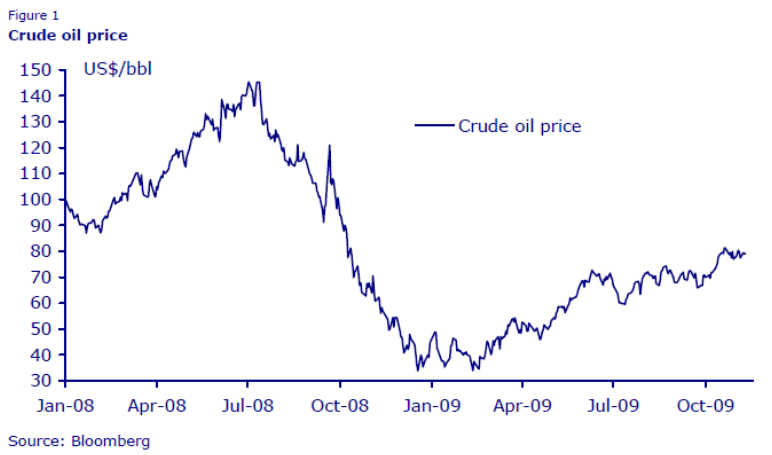
Still the oil break out also does raise the issue of whether markets are about to have a less exaggerated replay of last year’s giant fake out when oil spiked to US$147/bbl in mid July 2008 before collapsing to US$32/bbl in December. GREED & fear mentions this in the context of a widening in the “contango” of oil as longer dated oil prices have picked up over spot (see Figure 2). This suggests growing financial speculation on the contango driving oil into a spike, which was also what happened last year when the oil market slipped into contango in June 2008 (see Figure 3). There is also the issue of the about 100 floating oil tankers now seeking to lock in the longer dated prices.
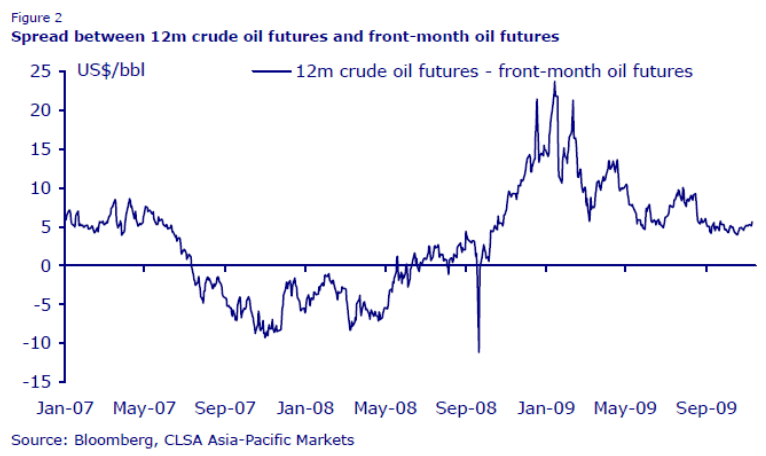
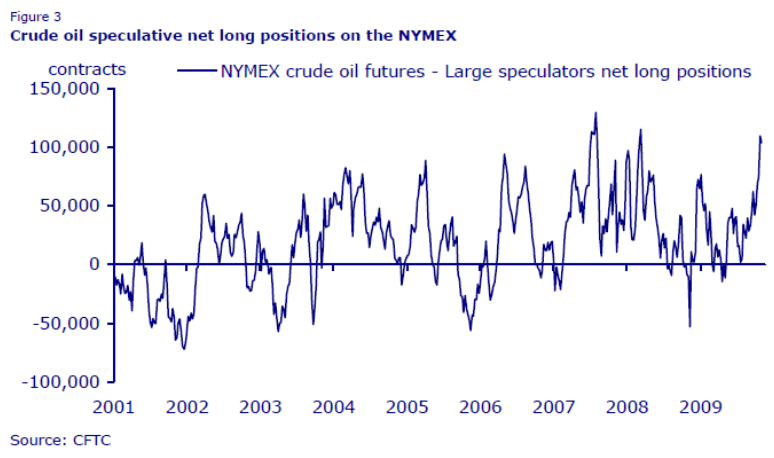
GREED & fear makes no pretense to be an expert on oil tankers or indeed the oil market. But the more oil spikes here the more the rise will sow the seeds for a broader correction in “risky” assets, just as happened last year, though this time GREED & fear’s guess is that it will be a case of a correction from US$90/bbl to the US$50-60 level rather than from US$150 to US$30. The reason is that an oil price above US$80, and certainly above US$90, will start to renew talk on demand destruction. But there is also another issue. With the base effect about to lead to a pick up in headline CPI globally, the higher oil price raises the risk of renewed inflationary noise, or perhaps GREED & fear should say “stagflation” noise as people look wrongly for a rerun of the 1970s.
This could lead to renewed concerns about imminent Fed tightening. If so, it will be, like last year, a massive fake out. For it is clear that a higher oil price is extremely deflationary in the sense that it is a tax on the US consumer, a consumer who by the way continues to suffer declining income growth (see Figure 4). This is certainly understood by the Fed chairman.
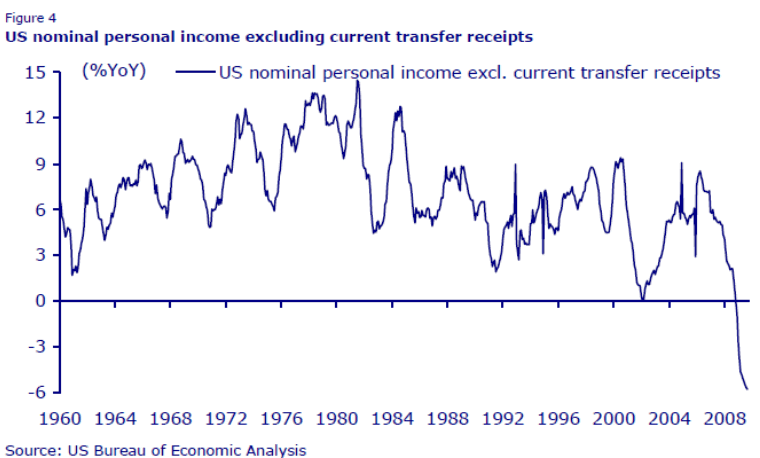
Still if all of the above is correct, the salient point for investors is that stocks are unlikely to correct properly unless oil corrects properly. So if oil starts spiking that may well be what is required to set up risky assets such as oil and equities for a decent correction where the only thing that will be rallying is the US dollar and the government bond market. So the message for now is to watch oil.
If this is the tactical view, one week in America has only served to reconfirm GREED & fear’s already held view that this is the new command economy. In this respect, it is interesting to note that the most sought after licence in the mortgage world is now a licence to underwrite Ginnie Mae mortgages since this now represents an opportunity to print money courtesy of booming Federal Housing Administration (FHA) government guaranteed mortgage lending. The command economy momentum has also been signalled by the Congressional decision to extend the US$8,000 First Time Home-Buyer Tax Credit to the end of April 2010 and create a new US$6,500 tax credit for qualified repeat home buyers who have owned their home for at least five years.
If all this is predictable, perhaps more illuminating to GREED & fear was a recent decision by the FDIC and other federal bank regulators to encourage banks to “restructure” commercial real estate loans. Thus, bank regulators including the FDIC issued guidelines in late October allowing banks to keep loans on their books as “performing” even if the value of the underlying commercial properties have fallen below the loan amount. The guidelines provide guidance to bank examiners and financial institutions working with commercial real estate borrowers who are “experiencing diminished operating cash flows, depreciated collateral values, or prolonged delays in selling or renting commercial properties”. The FDIC’s move seems to mean that banks should not foreclose on a loan, however bad the collateral, so long as interest payments are met. The regulators also noted that a restructuring may involve separating a troubled loan into one performing part and one nonperforming part, which would allow the bank to incur losses on only the nonperforming portion that is “not reasonably assured of repayment”.
This regulatory forbearance is the opposite of what happened in the early 1990s, post the savings and loan crisis, when US banks were forced by regulators to write down dodgy credits precipitating distressed sales and a V-shaped bottom. This time the FDIC is doing its best to delay market clearing in commercial real estate in the hope that these credits will eventually be ok with the passage of time. This is classic “Japanese-style” behaviour and raises the risk of zombie banks. It is certainly the opposite of what America has traditionally stood for in terms of a dynamic and flexible economy responding to market signals.
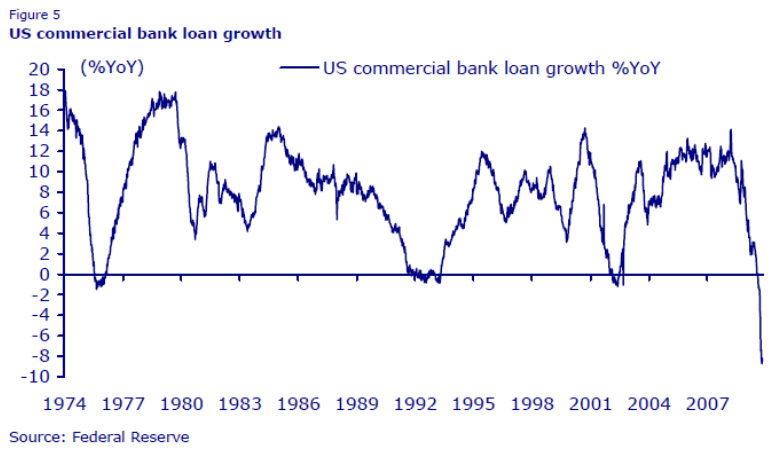
Zombie banks are also associated with a Japanese-style liquidity trap. GREED & fear has seen nothing in the past week to alter the view that this remains a real risk for the American economy. In fact it represents the current reality with bank lending continuing to fall and asset backed securitisation still well below previous boom levels. The demand for credit also remains weak judging by the latest Fed survey of loan officers published this week. Thus, a net 31.6% and 35.7% of banks reported weaker demand for commercial and industrial loans to large firms and small firms respectively in October, though this is down from 44.4% and 54.7% in July. While a net 24.5% and 42.9% of banks reported weaker demand in consumer loans and commercial real estate loans (see Figures 6 & 7). Banks’ exposure to troubled commercial real estate loans is also clear from the Fed survey. More than two-thirds of banks said that as much as 10% of their commercial real estate loans were in foreclosure.
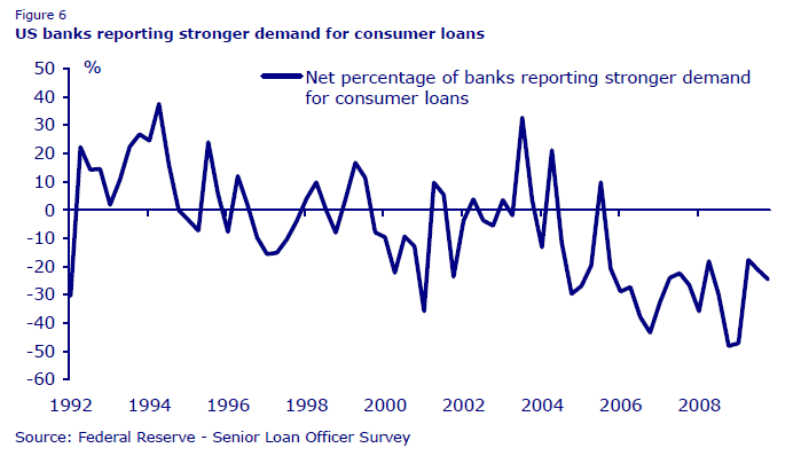
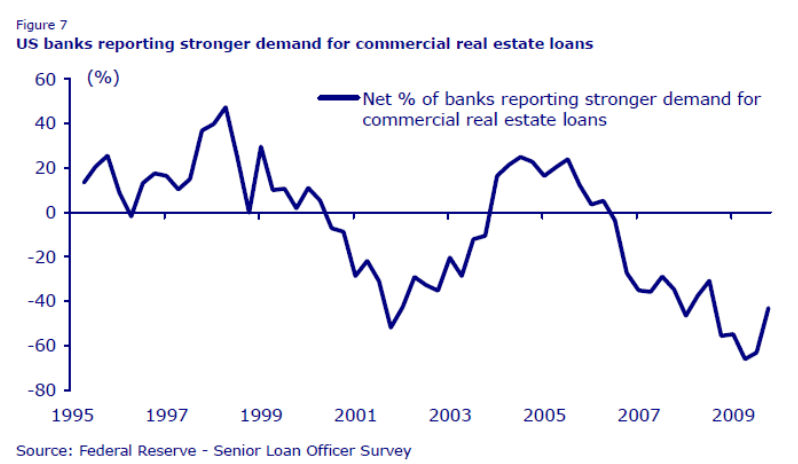
What about the supply of credit? Here GREED & fear would like to draw attention to an extremely interesting note published this week by CLSA’s US banks research team following a meeting with the head of Retail Financial Services (RFS) of JPMorgan (see CLSA research JPMorgan Chase – Meeting with head of retail, 9 November 2009 by New York-based bank analysts Mike Mayo and Chris Spahr). The meeting revealed that JPMorgan, the third-biggest retail bank in America, intends to reduce its consumer loans by 10-15% in 2010, and indicated total loans held within in its retail franchise (US$360bn in all) may decline by as much as two thirds in about 3-5 years on a net basis.
Such a potential contraction in retail loans has macroeconomic significance since JPMorgan has total consumer loans of about US$360bn, of which three quarters are mortgages and home equity loans. It is also the case that America’s other big commercial banks are also facing such loan “run downs” though not seemingly at quite the dramatic rate as JPMorgan which is pursuing higher ROE business.
All this raises the issue of what is going to replace all this disappearing lending. May be securitisation will explode. But perhaps more likely is the commencement of an age of government mandated lending where lending standards will be deliberately lowered again for the likes of a FHA or a Fannie or Freddie to try and fill the gap left by a disappearing private sector. Then there is also the issue of the credit card business from which banks are also now in retreat because pending legislation means banks will no longer be able to do risk-based lending when lending to holders of plastic. The new credit card law, scheduled to go into effect in February 2010, will limit banks’ ability to hike interest rates or fees and ban “unfair” or “deceptive” practices.
Meanwhile, the Fed’s latest loan survey also shows that banks are expecting to tighten the terms on credit card loans for both prime and nonprime borrowers ahead of legislation. For prime borrowers, more than half of the banks said they plan to reduce credit limits, 54% expect to widen the spread of interest rates over their cost of funds, 47% would require higher credit scores from borrowers and 38% said they would tighten their rules for annual fees. As for nonprime borrowers, 58% of banks expect to lower credit limits and 74% expect to widen their interest rate spreads.
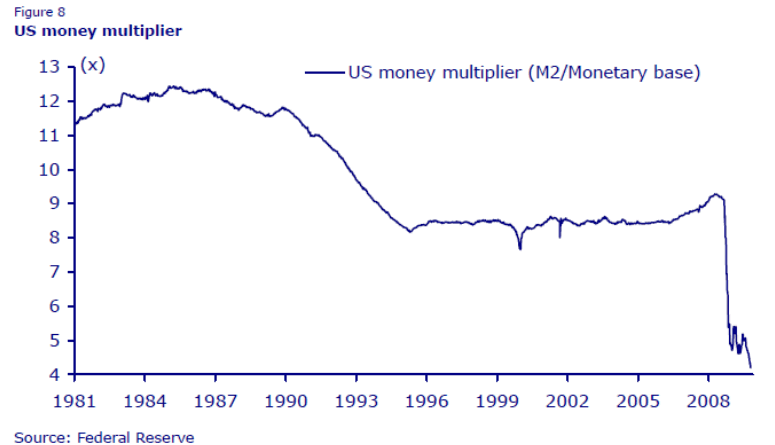
GREED & fear will, therefore, continue to wait for evidence that the credit multiplier is working in America before assuming America has escaped the risk of a liquidity trap. Still from a stock market perspective, the liquidity trap concept is unlikely to trigger near term stock market corrections because, however critical it may be, it is fundamentally a very abstract concept. It is also what would suggest short-term rates remain at zero which is what stock markets want to see. In this respect, a renewed further spike in oil is a much more obvious near term market catalyst which traders can understand.
Meanwhile, the onset of a Japanese-style risk-averse psychology also continues to be suggested by US mutual fund flows. Thus, US bond mutual funds recorded an estimated inflow of US$52.9bn in the first five weeks of this quarter. Year-to-date bond fund inflows were US$320.5bn, which is more than the cumulative inflows of US$248bn in the previous six years. By contrast, flows into domestic-equity mutual funds remain remarkably low given the massive percentage rally in the S&P500 this year. Indeed, there was an estimated outflow of US$18.4bn from domestic-equity funds in the five weeks ended 4 November and US$24.9bn year-to-date (see Figure 9). The only seeming rational for this behaviour is a desire to lock in income rather than pursue capital gain. This is exactly the sort of behaviour to be expected in a deflationary environment.
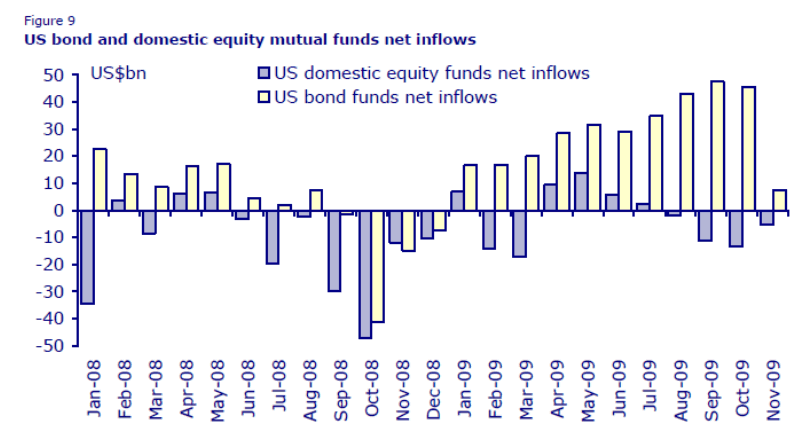
Speaking of Japan, GREED & fear has met a number of macro investors over the past week who have now put on the trade recommended here in recent months of shorting the 10-year JGB five years out. Such activity is also suggested by the recent pick up in the credit default swap (CDS) spread on Japanese government debt. Thus, the five-year CDS spread on Japanese government debt has doubled since the beginning of September from 37bp to 72bp, compared with 25bp on US Treasury debt, 56bp on British government debt and 73bp on Italian government debt (see Figure 10). This is interesting to GREED & fear since, when last in the US six months ago, nobody was talking about such a trade.
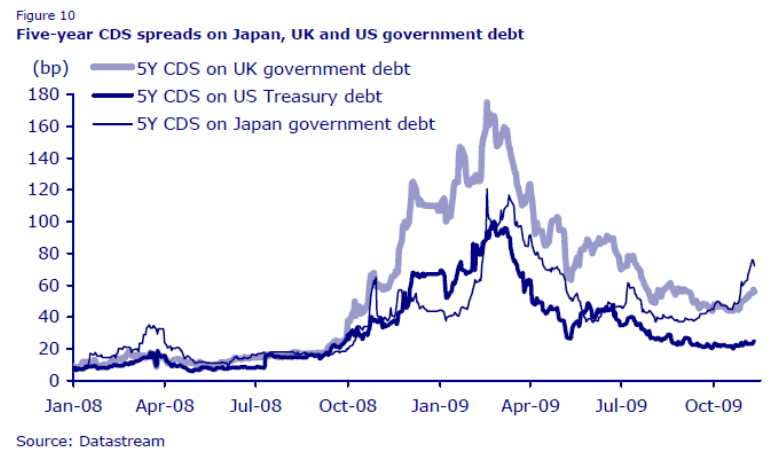
GREED & fear continues to believe that the trade makes sense so long as traders are not paying too much for the time value. Meanwhile, it will be important to keep an eye on how the new DPJ government handles the budget process in a year when tax revenues are expected to fall below Y40tn, compared with the previously projected Y46tn.
GREED & fear’s favourite Congressman, Ron Paul, is still trying to push his legislation through Congress to force much greater accountability on the Fed. GREED & fear has no idea of his progress. But it must be causing some waves since Fed apologists are writing self-serving articles seeking to defend the status quo. There was one such in Tuesday’s Wall Street Journal by former Fed governor Frederic Mishkin (see Wall Street Journal: “The Fed is already transparent”, 10 November 2009).
The arguments made continue utterly to fail to convince. Rather than “independent”, the Fed has in recent years become the chief enabler of the socialisation of credit risk, an ironic development given Pinball’s youthful relationship with Ayn Rand. Moreover, this trend has been accelerated under his successor Simple Ben with his simplistic adherence to the ludicrous notion of “Too Big to Fail”.
This is why GREED & fear was interested to read another op-ed article in the Wall Street Journal this week by Henry Kaufman arguing that under present trends, America was on course for a fully socialised credit system and that this represented the real threat to Fed independence (see Wall Street Journal: “The real threat to Fed independence”, 11 November 2009). The writer went on to call for a change in direction and for a rejection of “Too Big to Fail”. GREED & fear totally agrees. But the reality is that all the evidence points to an ever greater socialisation of credit risk with the federal government now guaranteeing 98% of mortgage backed security issuance. That Simple Ben does not seem to understand this only serves to highlight how simple he is. Meanwhile, when will the Feds guarantee jumbo mortgages?
By Christopher Wood
CLSA Asia-Pacific Markets is Asia’s leading, independent brokerage and investment group. The company provides equity broking, capital markets, merger and acquisition, and asset management services to global corporate and institutional clients.
© 2009 Copyright Christopher Wood - All Rights Reserved
Disclaimer: The above is a matter of opinion provided for general information purposes only and is not intended as investment advice. Information and analysis above are derived from sources and utilising methods believed to be reliable, but we cannot accept responsibility for any losses you may incur as a result of this analysis. Individuals should consult with their personal financial advisors.
IMPORTANT: The content of this report is subject to CLSA's Legal and Regulatory Notices as set out at
www.clsa.com/disclaimer.html, a hard copy of which may be obtained on request from CLSA Publications or CLSA Compliance
Group, 18/F, One Pacific Place, 88 Queensway, Hong Kong, telephone (852) 2600 8888.
© 2005-2022 http://www.MarketOracle.co.uk - The Market Oracle is a FREE Daily Financial Markets Analysis & Forecasting online publication.



